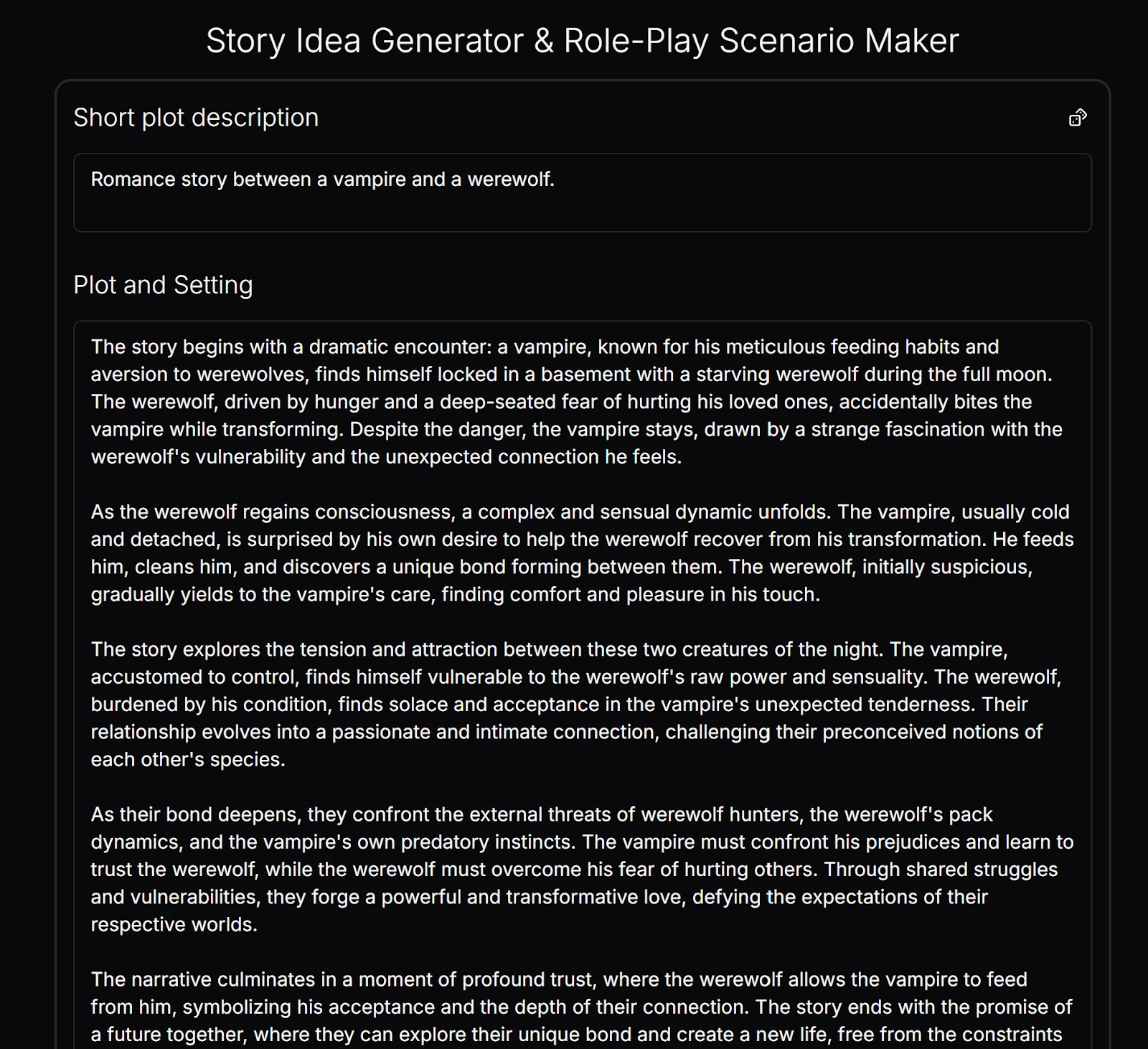How to Start a Story: 6 Steps to Hook Readers Instantly
Quick Summary
This guide walks you through essential steps to craft an opening that grabs attention and engages readers. From creating strong hooks to establishing character and setting, learn how to kick off your story effectively. Discover how DreamGen's tools can help you perfect your opening and bring your narrative to life. Check out the DreamGen blog for more AI tool reviews, guides, and tutorials.
Stuck on How to Start Your Dream Story?
The first few lines of your story matter more than you think. A great opening pulls readers into your world and sparks interest. Writing the perfect start can be tricky, but we’ve got you covered.
In this DreamGen guide, we’ll walk you through easy steps to create a strong opening that hooks readers. You’ll learn how to introduce your characters, set the tone, and ensure your story starts off with a bang.
Why Listen to Us?
At DreamGen, we’re experts in AI-powered storytelling, helping writers craft engaging narratives. With our deep understanding of story structure, this guide shows you how to master the art of starting a story. Our tips and strategies will empower you to create captivating beginnings that immediately hook readers.
What Does It Mean to Start a Story Strongly?
Starting a story strongly means creating an instant connection with your reader. It goes beyond a clever opening line, serving as the foundation for everything that follows. A strong beginning establishes the mood, sets the scene, and raises questions that invite the reader deeper.
It shows why your characters and their struggles matter. By weaving in tension, emotion, or mystery from the very first moment, you invite readers into the unfolding events.
Instead of weighing them down with background detail, you reveal the world through action and interaction. An opening like this gives readers a reason to invest in what happens next.
A strong story opening:
- Captures attention: The first lines or paragraphs should intrigue or surprise.
- Sets the tone: Whether it's suspenseful, humorous, or dramatic, the tone should be clear from the start.
- Introduces key elements: Readers should get a sense of the main character, setting, and conflict early on.
It gives readers just enough to spark curiosity and set up the plot, without revealing too much. Essentially, it’s a promise that the story will be worth their time
Getting Started With Your Story
Starting a story without preparation is like setting out on a journey without a map. To create a strong beginning, follow these foundational steps:
- Clarify your story’s purpose: Define the central theme or message. This guides the tone and direction of your narrative.
- Develop your main character: Create a protagonist with clear motivations and depth to drive the plot forward.
- Establish the setting: Decide on the time and place to immerse readers and set the mood.
- Outline the plot: Sketch the main events, including the inciting incident, climax, and resolution.

Not sure of what story to tell? DreamGen’s Story Idea Generator can help shape your story’s direction. You can also draw some inspiration from our rich collection of Story Ideas.
How to Begin Your Story to Engage Readers
Step 1: Start with a Strong Hook
A narrative hook is the opening that immediately captures the reader’s interest. Whether it’s a thought-provoking question, a gripping situation, or a mysterious character, the hook sets the tone and sparks curiosity.
Here are some techniques you can adopt:
- Begin with an intriguing question or statement: Something that provokes thought or makes readers want to know more. Example: “What if you could relive your worst memory?”
- Introduce a compelling character or situation: Present a character in a moment of tension or drama. Example: “She stood at the edge, looking down at the abyss, her heart racing.”
- Set the mood or atmosphere: Establish the setting in a way that evokes emotions. Example: “The fog rolled in thick, suffocating, as if it had a mind of its own.”
For example, in The Great Gatsby, F. Scott Fitzgerald hooks readers with: “In my younger and more vulnerable years, my father gave me some advice that I’ve been turning over in my mind ever since.”
Similarly, in Fahrenheit 451, Ray Bradbury opens with: “It was a pleasure to burn.” This line immediately sets a dark, dystopian tone that pulls readers in.
Step 2: Introduce Your Main Character Early
Introducing your protagonist early is crucial for forming a connection with the reader. The sooner readers understand who they are rooting for (or against), the more invested they become in the story.
The introduction should showcase the character’s personality, motivations, or challenges to establish emotional stakes from the beginning.
You can do this in two ways:
Showcase unique qualities or situations
Whether it’s a hero’s sense of justice or a villain’s hidden vulnerability, early character traits make the protagonist relatable or intriguing.
For instance, in The Hunger Games, Suzanne Collins introduces Katniss hunting for food, showing her survival skills and establishing her as a strong character facing challenges.
Create a sense of mystery or conflict
Introduce a problem or conflict the character faces to make readers want to follow their journey.
For example, in Harry Potter and the Sorcerer’s Stone, J.K. Rowling presents Harry as an orphan living under the stairs, immediately showing his unique situation and hinting at the mystery of his true identity.
Introducing your protagonist early invests readers in their growth and clarifies the stakes, creating emotional depth and engagement from the start.
Step 3: Set the Scene Effectively
Creating your story’s environment does more than show where events happen; it immerses readers and supports the tone.
Here’s how to set your scene effectively:
- Weave the setting into action: Introduce the setting as your character interacts with it.
Instead of saying, “It was a cold night,” show it through action: “She pulled her jacket tighter as the cold wind sliced through the streets.” This keeps the scene dynamic while grounding the reader.
- Use sensory details: Go beyond sight by adding sound, smell, and touch. For example, “The scent of fresh bread mingled with the hum of distant traffic” pulls the reader into the scene.
- Set the mood through the setting: The environment sets your story’s mood. A dark alley builds tension, while a sunny park brings calm. Pick details that mirror the tone you want the reader to feel and stay immersed in.
Tools like DreamGen can simplify this process. Its Scenario Codex manages multiple characters, plot, setting, and story style.
The Style setting controls how characters write, whether short and punchy or long and detailed, helping maintain a consistent, immersive environment.
Step 4: Present an Early Conflict or Question
Introducing a conflict or question early grabs the reader’s attention and gives your story direction.
Presenting a central conflict
Make it clear what’s at stake. Whether it’s an external problem or internal struggle, showing what the character must overcome gives the reader something to care about.
For example, in The Hunger Games, Katniss’s struggle for survival is introduced almost immediately, setting the stage for the story that follows.
Posing a compelling question
If you don’t want to reveal everything at once, introduce a mystery or question that keeps readers curious.
This could be as simple as, “Who was the mysterious figure watching her from the shadows?” or more complex, like, “Why is everyone in the town so afraid of the woods?”
QUICK TIP: Ensure the conflict or question connects to your character’s journey and the story’s plot. If it doesn’t, readers may feel disconnected.
Step 5: Use Engaging Dialogue
Dialogue is a powerful tool that brings characters to life, builds tension, and pushes the story forward.
It also reveals personality.. For example, a shy character may speak hesitantly, while a confident one might dominate the conversation. Instead of just telling the reader a character is confident, show it through their words and tone.
Dialogue also establishes relationships early on. Conversations between characters can reveal dynamics, whether it’s a heated argument, an awkward silence, or a warm exchange. These moments show how characters relate to each other.
An effective dialogue should:
- Sounds natural and real.
- Advance the plot, revealing key points, deepening conflicts, or providing important clues.
- Create tension to keep readers hooked.
When using advanced AI story generators, you have complete control over your dialogue using Steerability features.
For example, with DreamGen, you can guide your characters’ conversations by providing inline instructions that determine the direction of the dialogue, allowing you to create sharp exchanges or long, tense silences that fit the mood.
DreamGen also allows you to adjust response length and style using the Style Description in the Scenario Codex, giving you complete flexibility in shaping the dialogue’s tone and pacing.

By using dialogue to reveal character, relationships, and plot, you pull readers deeper into your narrative, creating a more engaging and dynamic story.
Step 6: Establish the Narrative Voice
The narrative voice is the lens through which readers experience your story. It shapes the tone, develops characters, and guides how the plot unfolds.
The first step in establishing your voice is choosing the right perspective. Decide whether your story will be told from first-person, third-person limited, or omniscient. Each perspective offers unique advantages:
- First-Person: Creates intimacy and immediacy by letting readers see events through one character’s eyes.
- Third-Person Limited: Focuses on one character, revealing thoughts and feelings while keeping some distance.
- Omniscient: Shares multiple characters’ thoughts and experiences, giving a broader view.
Once you choose a perspective, ensure:
- Consistency: Keep the narrative voice steady to avoid confusing readers.
- Alignment with Character’s Personality: The voice should reflect personality, values, and emotions authentically.
- Natural Engagement: Draw readers in from the start and keep them hooked.
Best Practices for Writing a Strong Story Opening
Here are a few tips to help you write an opening that hooks readers and sets the stage for the story:
- Avoid Info Dumps: Explaining everything at once is tempting, but too much backstory or detail can lose the reader’s attention. Instead, reveal information gradually through action, dialogue, and description, letting the reader discover the world naturally as the story unfolds.
- Show, Don’t Tell: Instead of telling readers how a character feels or what’s happening, show it through action, dialogue, and description. Let readers experience the story firsthand, creating a deeper connection with the characters and plot.
- Create a sense of urgency: Early in the story, hint at something important that demands attention. Whether it’s a problem the hero faces or a question to be answered, urgency pulls the reader forward and gives them reason to keep reading.
- Establish stakes early: Make readers see what’s at risk in your story. Whether it’s a personal goal, life-or-death, or a mystery needing answers, clear stakes help readers stay emotionally invested in the outcome.
- Revise and refine: The opening of your story is crucial, so don’t hesitate to rewrite it until it feels right. Revising and editing are key to making your opening tight, engaging, and effective. Take time to refine it until it pulls readers in from the first line.
Start Your Story Right with DreamGen’s Powerful Tools
A strong story opening is key to capturing your reader’s attention and setting the tone for the rest of your narrative. By using a compelling hook, introducing characters and setting with clarity, and hinting at early conflict, you can keep readers engaged from the very first line.
With DreamGen, crafting these key elements and further developing your story becomes easier than ever. Its interactive role-play, scenario codex, customizable story elements, and advanced narrative steering help you generate ideas, develop characters, and refine your narrative voice.
Ready to start your story? Bring your ideas to life today with DreamGen’s powerful writing tools.